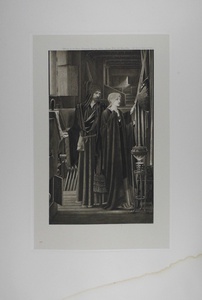| Method | Photogravure |
| Artist | after Sir Edward Coley Burne-Jones |
| Published | Published by the Berlin Photographic Company Berlin. _ London W.133 New Bond Street. _ New York 14 East 23rd Street. [c.1900] |
| Dimensions | Image 270 x 159 mm, Plate 341 x 215 mm, Sheet 667 x 507 mm |
| Notes |
Printed on India laid paper. Plate 77, taken from Burne-Jones' unfinished oil painting of his daughter, from 'The Work of Edward Burne-Jones, Ninety-One Photogravures Directly Reproduced from the Original Paintings'. Only two-hundred copies of the 'The Work of Edward Burne-Jones...' were produced, each of which was signed by Philip Burne-Jones, the eldest son of Edward. Set within a panelled chamber, a wizard stands beside a young maiden. With his left hand, the wizard holds back a curtain, revealing to the maiden a shipwreck within a magic mirror, possibly referencing Shakespeare's 'Tempest', whilst with his right hand, turns the pages of an ancient book. Beside the maiden, resting upon a tripod, is a copper cauldron, heated by a brazier. It is believed that the wizard is Burne-Jones in his younger years, whilst the young maiden is said to have been modelled on Frances Graham Horner, the daughter of Burne-Jones' primary patron, William Graham. The painting from which this photogravure was taken is now in the collection of Birmingham Museums and Art Gallery. Sir Edward Coley Burne-Jones, 1st Bt (1833-1898) was a painter and designer closely associated with the later phase of the Pre-Raphaelite movement. Burne-Jones met William Morris as an undergraduate of Exeter college, Oxford, whilst studying for a degree in theology. The pair went on to work very closely together on numerous decorative arts projects including stained glass windows, tapestries and illustrations. Originally intending to become a church minister, Burne-Jones never finished his degree, choosing instead to pursue an artistic career under the influence of Dante Gabriel Rossetti. Rossetti heavily inspired his early work, but by the 1860's his idiosyncratic style was beginning to develop. His mature work, however different in total effect, is rich in conscious echoes of Botticelli, Mantegna and other Italian masters of the Quattrocento. Thusly, Burne Jones' later paintings of classical and medieval subjects are some of the most iconic of the Pre-Raphaelite movement. He was at the height of his popularity during the 1880's, though his reputation began to decline with the onset of the Impressionists. He was created a baronet in 1894, when he formally hyphenated his name. The Berlin Photographic Company, (1880 - 1920; fl) or the Berlin Photographische Gesellschaft, was a German print publishers who specialised in photogravures after Old Masters and contemporary painters. High quality photographs were taken of the original works. The negatives were then exposed onto a gelatin covered copper plate, etched with acid, and printed in a similar fashion to an engraving. The main series of the Berlin Photographic Company's publications is kept together at Blythe House, West Kensington. Condition: Foxing and discolouration to margins, water stain to lower edge of sheet, not affecting image. |
| Framing | unmounted |
| Price | £375.00 |
| Stock ID | 41634 |

